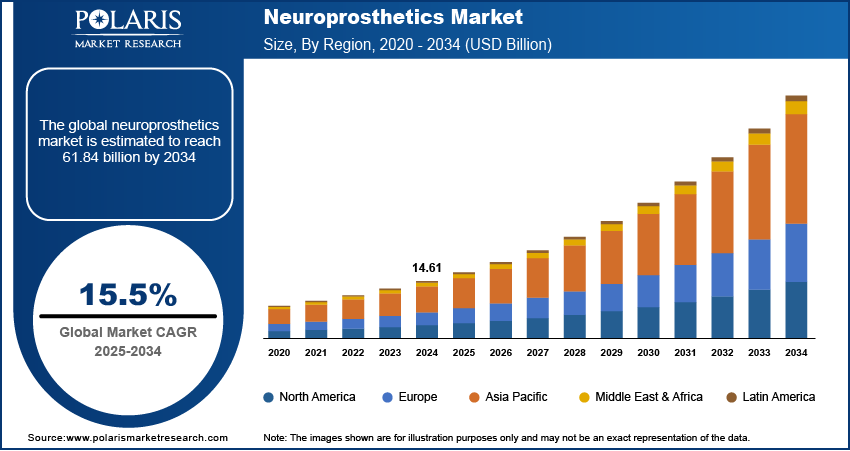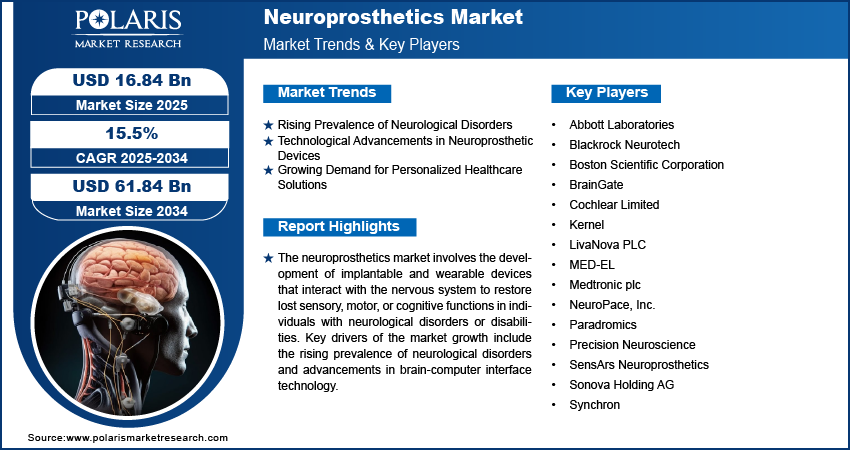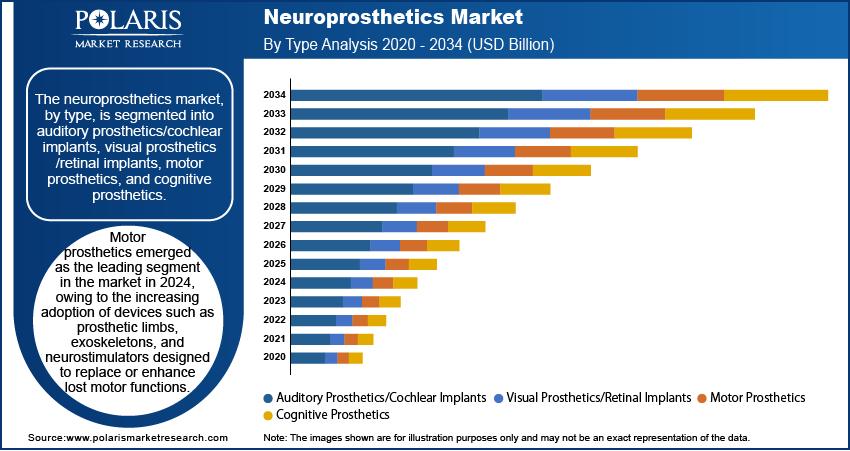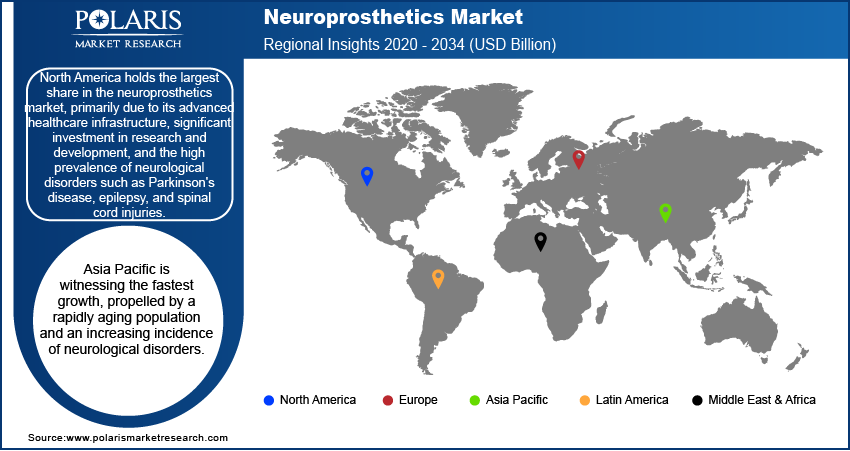
Neuroprosthetics Market Size, Share, Trends, Industry Analysis Report
: By Type (Auditory Prosthetics/Cochlear Implants, Visual Prosthetics/Retinal Implants, Motor Prosthetics, and Cognitive Prosthetics), Technology, Application, and Region (North America, Europe, Asia Pacific, Latin America, and Middle East & Africa) – Market Forecast, 2025–2034
- Published Date:Aug-2025
- Pages: 119
- Format: PDF
- Report ID: PM3136
- Base Year: 2024
- Historical Data: 2020-2023
Market Overview
The global neuroprosthetics market size was valued at USD 14.61 billion in 2024, growing at a CAGR of 15.5% during 2025–2034. The rising prevalence of neurological diseases and increased investments in research and development are a few of the key factors driving market growth.
Key Insights
- The motor prosthetics segment led the market in 2024. The segment’s dominance is primarily attributed to the growing adoption of devices designed to replace or enhance lost motor functions.
- The cognitive disorders segment is anticipated to register the highest growth rate, owing to the growing incidence of cognitive impairments.
- North America accounted for the largest market share in 2024, driven by the region’s advanced healthcare infrastructure and significant investments in R&D.
- Asia Pacific is witnessing the fastest growth. The high prevalence of neurological disorders and a rapidly aging population contribute to the region’s robust growth.
Industry Dynamics
- The rising prevalence of neurological disorders has created increased demand for neuroprosthetic solutions for restoring lost functions and improving life quality.
- The integration of artificial intelligence and machine learning, which enables more precise neural stimulation and improved patient outcomes, fuels market demand.
- Advances in miniaturization and minimally invasive technologies are expected to present several market opportunities.
- The high cost of neuroprosthetic products may hinder market growth.
Market Statistics
2024 Market Size: USD 14.61 billion
2034 Projected Market Size: USD 61.84 billion
CAGR (2025-2034): 15.5%
North America: Largest Market in 2024
AI Impact on Neuroprosthetics Market
- The ability of AI to interpret neural signals with greater precision enables smoother and more natural control of prosthetic devices.
- Machine learning algorithms adapt prosthetic responses over time to match the user’s movement patterns and preferences.
- AI-powered sensory feedback systems restore a sense of touch, improving functionality and user confidence.
- Real-time signal processing from AI enhances coordination between brain activity and device movement. This helps accelerate rehabilitation outcomes.

To Understand More About this Research: Request a Free Sample Report
The neuroprosthetics market involves medical devices that interface with the nervous system to restore lost sensory or motor functions in patients with neurological disorders, spinal cord injuries, or limb amputations.
Key drivers of the neuroprosthetics market growth include the rising prevalence of neurological diseases such as Parkinson’s disease, epilepsy, and stroke, along with advancements in brain-computer interface technology. Increasing investments in research and development, coupled with growing demand for implantable neuroprosthetic devices, further contribute to market expansion. Trends such as the integration of artificial intelligence and machine learning in neuroprosthetic systems and the development of minimally invasive implant techniques are expected to drive innovation and adoption.
Market Dynamics
Rising Prevalence of Neurological Disorders
The increasing incidence of neurological disorders significantly propels the neuroprosthetics market. According to the World Health Organization (WHO), approximately 50 million people worldwide were living with epilepsy as of 2022, with nearly 80% residing in low- and middle-income countries. This growing patient population highlights the demand for neuroprosthetic solutions to restore lost functions and improve quality of life.
Technological Advancements in Neuroprosthetic Devices
The integration of artificial intelligence and machine learning is driving significant advancements in neuroprosthetic devices, enabling more precise neural stimulation and improved patient outcomes. Emerging technologies such as brain-computer interfaces (BCIs) and adaptive algorithms are further enhancing device responsiveness and user adaptability. Additionally, the miniaturization of components and wireless connectivity is expanding applications beyond clinical settings into daily life. These innovations improve functionality and also reduce costs, making neuroprosthetics more accessible to a broader patient population.
Growing Demand for Personalized Healthcare Solutions
The shift towards personalized healthcare is accelerating the adoption of neuroprosthetics, as these devices can be customized to align with individual patient physiology and treatment goals. Advances in neural mapping and real-time data analytics now allow for dynamic adjustments, optimizing therapeutic efficacy and minimizing side effects. Furthermore, the integration of patient-specific biomarkers and predictive modeling is enabling proactive device calibration, ensuring long-term usability and performance. This patient-centric approach improves clinical outcomes and also fosters greater adherence and quality of life. The neuroprosthetics market is poised to become a cornerstone of next-generation rehabilitative and therapeutic strategies as the demand for precision medicine grows.

Segment Insights
Market Assessment – Type-Based Insights
The neuroprosthetics market, by type, is segmented into auditory prosthetics/cochlear implants, visual prosthetics/retinal implants, motor prosthetics, and cognitive prosthetics. Motor prosthetics emerged as the leading segment in the market in 2024. This dominance is attributed to the increasing adoption of devices such as prosthetic limbs, exoskeletons, and neurostimulators designed to replace or enhance lost motor functions. Technological advancements, including the development of sophisticated sensors and materials, have resulted in more functional and user-friendly motor prosthetics, thereby driving their widespread acceptance.
The visual prosthetics/retinal implants segment is experiencing the fastest growth within the market. This rapid expansion is largely due to the increasing prevalence of retinal degenerative diseases. For instance, age-related macular degeneration is a leading cause of vision loss among Americans aged 50 and older, affecting approximately 1 in 10 individuals in the US alone. The rising incidence of such conditions has spurred significant research and development efforts, leading to innovative retinal implant technologies aimed at restoring vision and improving patient outcomes.
Market Evaluation – Technology-Based Insights
The neuroprosthetics market, by technology, is segmented into spinal cord stimulation (SCS), vagus nerve stimulation (VNS), sacral nerve stimulation (SNS), and deep brain stimulation (DBS). The spinal cord stimulation (SCS) segment dominated the market in 2024. This prominence is largely due to the widespread application of SCS devices in managing chronic pain conditions, offering patients significant relief and improved quality of life. Technological advancements have further enhanced the efficacy and adoption of SCS systems, solidifying their position in the market.
Market Outlook – Application-Based Insights
The neuroprosthetics market, by application, is segmented into cognitive disorders, motor neuron disorders, and physiological disorders. The motor neuron disorders segment held the largest market share in 2024. This dominance is primarily due to the increasing prevalence of neurological conditions such as Parkinson's disease and epilepsy. According to the Parkinson's Foundation, nearly one million individuals in the United States are living with Parkinson's disease, with projections estimating this number will rise to 1.2 million by 2030. Similarly, the World Health Organization reports that approximately 5 million people are diagnosed with epilepsy each year globally. The substantial impact of these disorders on patients' quality of life has led to a heightened demand for neuroprosthetic devices aimed at restoring motor functions and managing symptoms effectively.
Tthe cognitive disorders segment is anticipated to experience the highest growth rate. This surge is attributed to the rising incidence of cognitive impairments, including Alzheimer's disease and severe depression. As the global population ages, the prevalence of these conditions is expected to increase, driving the need for innovative neuroprosthetic solutions that can enhance cognitive functions and improve patient outcomes. Advancements in neurotechnology and increased research funding are further propelling the development of devices tailored to address cognitive deficits, thereby contributing to the rapid expansion of this market segment.

Regional Analysis
By region, the study provides the neuroprosthetics market insights into North America, Europe, Asia Pacific, Latin America, and the Middle East & Africa. North America held the largest share in the neuroprosthetics market in 2024, primarily due to its advanced healthcare infrastructure, significant investment in research and development, and the high prevalence of neurological disorders such as Parkinson's disease, epilepsy, and spinal cord injuries. The region's well-established medical facilities and the presence of key industry players facilitate the development and adoption of innovative neuroprosthetic devices. Additionally, favorable reimbursement policies and healthcare insurance coverage support the widespread use of these technologies. The combination of a sizable patient population and robust support systems positions North America as the leading market for neuroprosthetics.
The Europe neuroprosthetics market is experiencing significant growth, driven by a robust healthcare infrastructure and a high prevalence of neurological disorders. Countries such as Germany, France, and the UK are at the forefront, with extensive adoption of neuroprosthetic solutions, particularly in motor and cognitive prosthetics. The region benefits from supportive government policies and substantial funding for neurological research, fostering innovation and development in neuroprosthetic technologies. Additionally, the increasing awareness about neuroprosthetic applications and the rising elderly population contribute to the market's expansion.
Asia Pacific is witnessing the fastest growth, propelled by a rapidly aging population and an increasing incidence of neurological disorders. Countries like Japan, China, and India are witnessing a rising demand for neuroprosthetic devices. Japan leads the region in neuroprosthetic adoption due to its advanced healthcare technologies and a significant elderly population. In China and India, expanding healthcare infrastructure and growing investments in medical research are enhancing the accessibility and development of neuroprosthetic solutions. The region's growth is further supported by increasing awareness of neuroprosthetic applications and government initiatives aimed at improving healthcare services.

Key Players and Competitive Insights
The neuroprosthetics market features several key players actively contributing to advancements in the field. Medtronic plc specializes in spinal cord and deep brain stimulation devices, addressing chronic pain and movement disorders. Abbott Laboratories offers a range of neuromodulation products, including implantable devices for chronic pain and movement disorders. Boston Scientific Corporation develops neurostimulation systems for pain management and neurological conditions. Cochlear Limited is renowned for its cochlear implants, providing hearing solutions for individuals with profound hearing loss. Sonova Holding AG also focuses on hearing care solutions, including advanced cochlear and acoustic implants. LivaNova PLC offers neuromodulation devices, particularly for epilepsy and treatment-resistant depression.
In this competitive landscape, companies like Medtronic plc, Abbott Laboratories, and Boston Scientific Corporation have established strong market positions through extensive product portfolios and continuous innovation in neurostimulation technologies. Their global presence and significant investment in research and development enable them to address a wide range of neurological disorders effectively. Cochlear Limited and Sonova Holding AG have made significant contributions to auditory prosthetics, offering advanced solutions for hearing impairments and maintaining a robust market presence. A few major players are Abbott Laboratories; Blackrock Neurotech; Boston Scientific Corporation; BrainGate; Cochlear Limited; Kernel; LivaNova PLC; MED-EL; Medtronic plc; NeuroPace, Inc.; Paradromics; Precision Neuroscience; SensArs Neuroprosthetics; Sonova Holding AG; and Synchron.
Medtronic plc is a prominent healthcare technology company specializing in medical devices designed to alleviate pain, restore health, and extend life. Their neurostimulation systems, particularly in deep brain stimulation (DBS), are utilized to manage neurological disorders such as Parkinson's disease and essential tremors. In January 2024, Medtronic received FDA approval for its Percept RC neurostimulator, which features BrainSense technology. This advancement allows for the capture and recording of brain signals, enabling personalized treatment for patients with movement disorders.
Abbott Laboratories is a global healthcare leader with a diversified portfolio spanning medical devices, diagnostics, pharmaceuticals, and nutrition. In neuroprosthetics, Abbott has pioneered advanced neuromodulation therapies, including the Liberta RC Deep Brain Stimulation (DBS) system, which combines directional lead technology with remote programming to optimize treatment for Parkinson’s disease and essential tremor. The company also offers the Proclaim XR Spinal Cord Stimulation (SCS) system, leveraging low-dose BurstDR technology for chronic pain management. Abbott’s focus on AI-driven adaptive therapies and miniaturized implantable devices underscores its commitment to expanding neuroprosthetic applications into mental health and functional restoration.
List of Key Companies
- Abbott Laboratories
- Blackrock Neurotech
- Boston Scientific Corporation
- BrainGate
- Cochlear Limited
- Kernel
- LivaNova PLC
- MED-EL
- Medtronic plc
- NeuroPace, Inc.
- Paradromics
- Precision Neuroscience
- SensArs Neuroprosthetics
- Sonova Holding AG
- Synchron
Neuroprosthetics Industry Developments
- February 2025: Medtronic received FDA approval for its BrainSense Adaptive Deep Brain Stimulation (aDBS) system, marking the first adaptive DBS device that personalizes therapy in real-time based on individual brain activity.
- January 2024: Abbott Laboratories secured FDA approval for the Liberta RC DBS system, noted for being the smallest rechargeable device in its category and requiring minimal recharges annually.
Neuroprosthetics Market Segmentation
By Type Outlook (Revenue – USD Billion, 2020–2034)
- Auditory Prosthetics/Cochlear Implants
- Visual Prosthetics/Retinal Implants
- Motor Prosthetics
- Cognitive Prosthetics
By Technology Outlook (Revenue – USD Billion, 2020–2034)
- Spinal Cord Stimulation (SCS)
- Vagus Nerve Stimulation (VNS)
- Sacral Nerve Stimulation (SNS)
- Deep Brain Stimulation (DBS)
By Application Outlook (Revenue – USD Billion, 2020–2034)
- Cognitive Disorders
- Motor Neuron Disorders
- Physiological Disorders
By Regional Outlook (Revenue – USD Billion, 2020–2034)
- North America
- US
- Canada
- Europe
- Germany
- France
- UK
- Italy
- Spain
- Netherlands
- Russia
- Rest of Europe
- Asia Pacific
- China
- Japan
- India
- Malaysia
- South Korea
- Indonesia
- Australia
- Vietnam
- Rest of Asia Pacific
- Middle East & Africa
- Saudi Arabia
- UAE
- Israel
- South Africa
- Rest of Middle East & Africa
- Latin America
- Mexico
- Brazil
- Argentina
- Rest of Latin America
Report Scope
|
Report Attributes |
Details |
|
Market Size Value in 2024 |
USD 14.61 billion |
|
Market Size Value in 2025 |
USD 16.84 billion |
|
Revenue Forecast by 2034 |
USD 61.84 billion |
|
CAGR |
15.5% from 2025 to 2034 |
|
Base Year |
2024 |
|
Historical Data |
2020–2023 |
|
Forecast Period |
2025–2034 |
|
Quantitative Units |
Revenue in USD billion and CAGR from 2025 to 2034 |
|
Report Coverage |
Revenue Forecast, Market Competitive Landscape, Growth Factors, and Trends |
|
Segments Covered |
|
|
Regional Scope |
|
|
Competitive Landscape |
|
|
Report Format |
|
|
Customization |
Report customization as per your requirements with respect to countries, regions, and segmentation. |
How is the report valuable for an organization?
Workflow/Innovation Strategy: The neuroprosthetics market has been segmented into detailed segments of type, technology, and application. Moreover, the study provides the reader with a detailed understanding of the different segments at both the global and regional levels.
Growth/Marketing Strategy: The growth and marketing strategy in the neuroprosthetics market focuses on technological advancements, strategic collaborations, and expanding healthcare accessibility. Companies invest in research and development to enhance neurostimulation and brain-computer interface technologies. Partnerships with healthcare providers and research institutions facilitate product innovation and clinical adoption. Regulatory approvals and reimbursement policies play a crucial role in market expansion. Additionally, awareness programs and direct engagement with healthcare professionals drive the adoption of neuroprosthetic solutions, particularly in emerging markets.
FAQ's
The neuroprosthetics market size was valued at USD 14.61 billion in 2024 and is projected to grow to USD 61.84 billion by 2034.
The market is projected to register a CAGR of 15.5% during the forecast period.
North America had the largest share of the market in 2024.
The neuroprosthetics market features several key players actively contributing to advancements in the field. Medtronic plc specializes in spinal cord and deep brain stimulation devices, addressing chronic pain and movement disorders. Abbott Laboratories offers a range of neuromodulation products, including implantable devices for chronic pain and movement disorders. Boston Scientific Corporation develops neurostimulation systems for pain management and neurological conditions. Cochlear Limited is renowned for its cochlear implants, providing hearing solutions for individuals with profound hearing loss.
The spinal cord stimulation (SCS) segment dominated the market in 2024 due to the widespread application of SCS devices in managing chronic pain conditions.
The motor neuron disorders segment held the largest market share in 2024 due to the increasing prevalence of neurological conditions such as Parkinson's disease and epilepsy.
Neuroprosthetics refers to a field of medical technology that involves the development and use of implantable devices to restore or enhance neurological functions in individuals with disabilities or neurological disorders. These devices interface with the nervous system to assist in movement, sensory perception, or cognitive functions. Common applications include cochlear implants for hearing loss, deep brain stimulators for Parkinson’s disease, spinal cord stimulators for pain management, and brain-computer interfaces for individuals with paralysis. Neuroprosthetic devices work by transmitting electrical signals to stimulate or modulate neural activity, helping patients regain lost functions and improve their quality of life.
A few key trends in the market are described below: Advancements in Brain-Computer Interfaces (BCIs): Increasing research and development in BCIs to enhance communication and mobility for individuals with severe neurological conditions. Integration of Artificial Intelligence (AI): AI-driven neuroprosthetics are improving signal processing, personalization, and real-time adaptation for better patient outcomes. Expansion of Deep Brain Stimulation (DBS): DBS technology is being increasingly adopted for treating movement disorders, epilepsy, and psychiatric conditions. Miniaturization and Wireless Connectivity: Development of smaller, wireless, and rechargeable neuroprosthetic devices for enhanced patient comfort and usability.
A new company entering the neuroprosthetics market can focus on developing innovative brain-computer interface (BCI) technologies, which have growing applications in paralysis treatment and cognitive disorders. Advancements in non-invasive neurostimulation devices can also provide a competitive edge by addressing patient concerns related to surgical procedures. Investing in AI-driven adaptive neuroprosthetics can enhance device personalization and real-time response. Additionally, focusing on affordability and accessibility in emerging markets can help capture an underserved patient base. Strategic partnerships with research institutions and healthcare providers can accelerate product development and clinical adoption.
Companies manufacturing, distributing, or purchasing neuroprosthetics and related products, and other consulting firms must buy the report.
